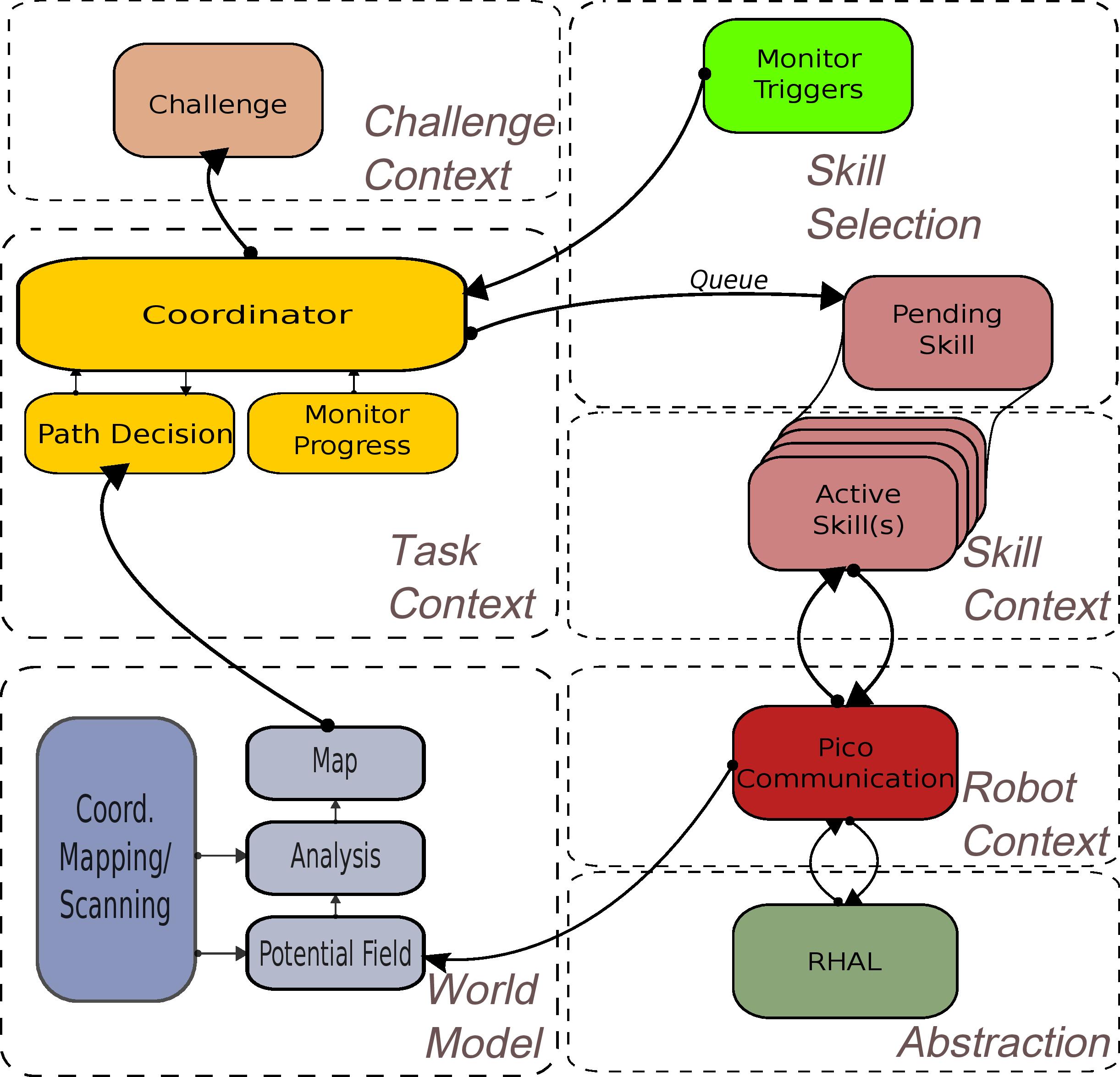Embedded Motion Control 2015 Group 1: Difference between revisions
| Line 40: | Line 40: | ||
In the table below, the above requirements are summarized according to the FURPS structure. | In the table below, the above requirements are summarized according to the FURPS structure. | ||
{| border="2" class="wikitable" | {| border="2" class="wikitable" style="text-align:center; width:200px; height:200px;" | ||
|+ '''Summary of requirements according to the FURPS model.''' | |+ '''Summary of requirements according to the FURPS model.''' | ||
|- | |- | ||
Revision as of 17:03, 17 May 2015
Embedded Motion Control (EMC) Group 1 is a multidisciplinar and multilingual project group working on the 'A-MAZE-ING PICO'. This wikipedia page consists of the weelky progress presented in the journal, the written report and some other practical and useful stuff.
The report focussus on the individual components of the software architecture, this includes basic idea description, mathematical analyses and possible software implementation.
Journal
The proces of developing a software architecuter and the implementation requires great coordination and collaboration. This journal will be updated to present and track the progress of the group. This journal includes weekly progress, countered problems and divided tasks.
Meetings
1. Thursday 23: 12:45 - 13:30 in OGO19
2. Wednesday 29: 10:15-11:00 in OGO17
3. Friday 1 May: ?-? in ?
Design Architecture
In this section, the initial idea of an embedded software design will be discussed. The main goal of the design is to make the Pico robot able to solve a maze. In this brief report, the requirements, functions, components specifications, and the interfaces of such a system will be discussed.
Requirements
The requirements of the system will be divided according to the FURPS model. The abbreviation of this model stands for Functionality, Usability, Reliability, Performance, and Supportability. Functionality in this case denotes the features and capabilities of the system. Usability includes the human factors, consistency, and aesthetics. Reliability stands for the failure frequency, accuracy, predictability, et cetera. Performance here means the efficiency, speed, response, i.e. measures of system performance. Finally, the supportability incorporates testability, maintainability, configurability, and so forth.
The main requirement of the system will be to navigate the maze. It must be completed according to the challenge specification, which forms the main functional aspect of the requirements.
Furthermore, the system design must be robust. The layout of the system must constitute all possible functions to account for the various system architecture, which enable the usability of that design. To achieve this, possible fault modes can be taken into account.
Also, the system design should pose a robust solution. This means the provided system solution must be robust enough to cope with the environmental uncertainties, so that the solution as a whole is reliable.
Next, the doors in the maze should be handled correctly. The behaviour of the door should be analysed to help differentiate the door from the wall. Firstly, the robot should be able to recognize a door from a wall and, secondly, cross the door.
Fifthly, the generated design should be tested for its reliability, and accordingly changes are required to be captured to improve the same.
Furthermore, The major functional requirement of the robot is the ability to solve the maze on its own.
Next, the given hardware (PICO robot) must be used for the maze challenge without any modification and additional components mounted on it.
Penultimately, the performance requirement of taking quick decision is one of the essential factors for the PICO robot for completing the challenge within 7 minutes.
And finally, the need for smart decision making is a crucial necessity due to the fact that the environment changes.
In the table below, the above requirements are summarized according to the FURPS structure.
| Requirement | F | U | R | P | S |
|---|---|---|---|---|---|
| Navigate the maze | x | ||||
| Subsystem based design | x | ||||
| Adaptable to environment | x | ||||
| Door handling | x | ||||
| Testing and simulation | x | ||||
| Autonomous operation | x | ||||
| Use given hardware | x | ||||
| Fast decision making | x | ||||
| Smart decision making | x |
Potential Field
Report-like explanation of the potential field: the working principle, the underlying mathematics and, the implementation.
Lower Level Skills
Explanation of the decision making algorithm and the low level skills used to drive the robot.
Corridor Challenge
Preparation of the Embedded Motion Control #Corridor Competition and the results shown in a short movie.
Appendix
The Appendix consists of the unrelevant parts of the report. This includes a list of the group members and some tips and tricks for programming.
Group members
Group 1 consists of the following members:
| Name | Student nr | |
|---|---|---|
| Maurice Poot | 0782270 | m.m.poot@student.tue.nl |
| Timo Ravensbergen | 0782767 | t.ravensbergen@student.tue.nl |
| Bart Linssen | 0786201 | a.j.m.linssen@student.tue.nl |
| Rinus Hoogesteger | 0757249 | m.m.hoogesteger@student.tue.nl |
| Nitish Rao | 0927795 | n.rao@student.tue.nl |
| Aakash Amul | 0923321 | a.v.h.amul@student.tue.nl |
| Ignacio Vazquez | 0871475 | i.s.vazquez.rodarte@student.tue.nl |
Qt from terminal
If Qt Creator is not run from the terminal, the programs inside cannot connect to the ROS master. To be able to run Qt Creator from the desktop without any problems, follow a similar procedure to the one that is used in the Customizing Ubuntu tutorial for the Terminator file:
Edit
~/.local/share/applications/QtProject-qtcreator.desktop
and change the third line to:
Exec=bash -i -c /home/rinus/qtcreator-3.3.2/bin/qtcreator
This will run QtCreator from a terminal even if the desktop icon is used.
